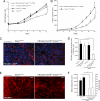Dicer-dependent endothelial microRNAs are necessary for postnatal angiogenesis
- PMID: 18779589
- PMCID: PMC2544582
- DOI: 10.1073/pnas.0804597105
Dicer-dependent endothelial microRNAs are necessary for postnatal angiogenesis
Abstract
Posttranscriptional gene regulation by microRNAs (miRNAs) is important for many aspects of development, homeostasis, and disease. Here, we show that reduction of endothelial miRNAs by cell-specific inactivation of Dicer, the terminal endonuclease responsible for the generation of miRNAs, reduces postnatal angiogenic response to a variety of stimuli, including exogenous VEGF, tumors, limb ischemia, and wound healing. Furthermore, VEGF regulated the expression of several miRNAs, including the up-regulation of components of the c-Myc oncogenic cluster miR-17-92. Transfection of endothelial cells with components of the miR-17-92 cluster, induced by VEGF treatment, rescued the induced expression of thrombospondin-1 and the defect in endothelial cell proliferation and morphogenesis initiated by the loss of Dicer. Thus, endothelial miRNAs regulate postnatal angiogenesis and VEGF induces the expression of miRNAs implicated in the regulation of an integrated angiogenic response.
Conflict of interest statement
The authors declare no conflict of interest.
Figures




References
-
- He L, Hannon GJ. MicroRNAs: Small RNAs with a big role in gene regulation. Nat Rev Genet. 2004;5:522–531. - PubMed
-
- Vasudevan S, Tong Y, Steitz JA. Switching from repression to activation: microRNAs can up-regulate translation. Science. 2007;318:1931–1934. - PubMed
-
- Bernstein E, et al. Dicer is essential for mouse development. Nat Genet. 2003;35:215–217. - PubMed
-
- Yang WJ, et al. Dicer is required for embryonic angiogenesis during mouse development. J Biol Chem. 2005;280:9330–9335. - PubMed
Publication types
MeSH terms
Substances
Grants and funding
LinkOut - more resources
Full Text Sources
Other Literature Sources
Molecular Biology Databases

